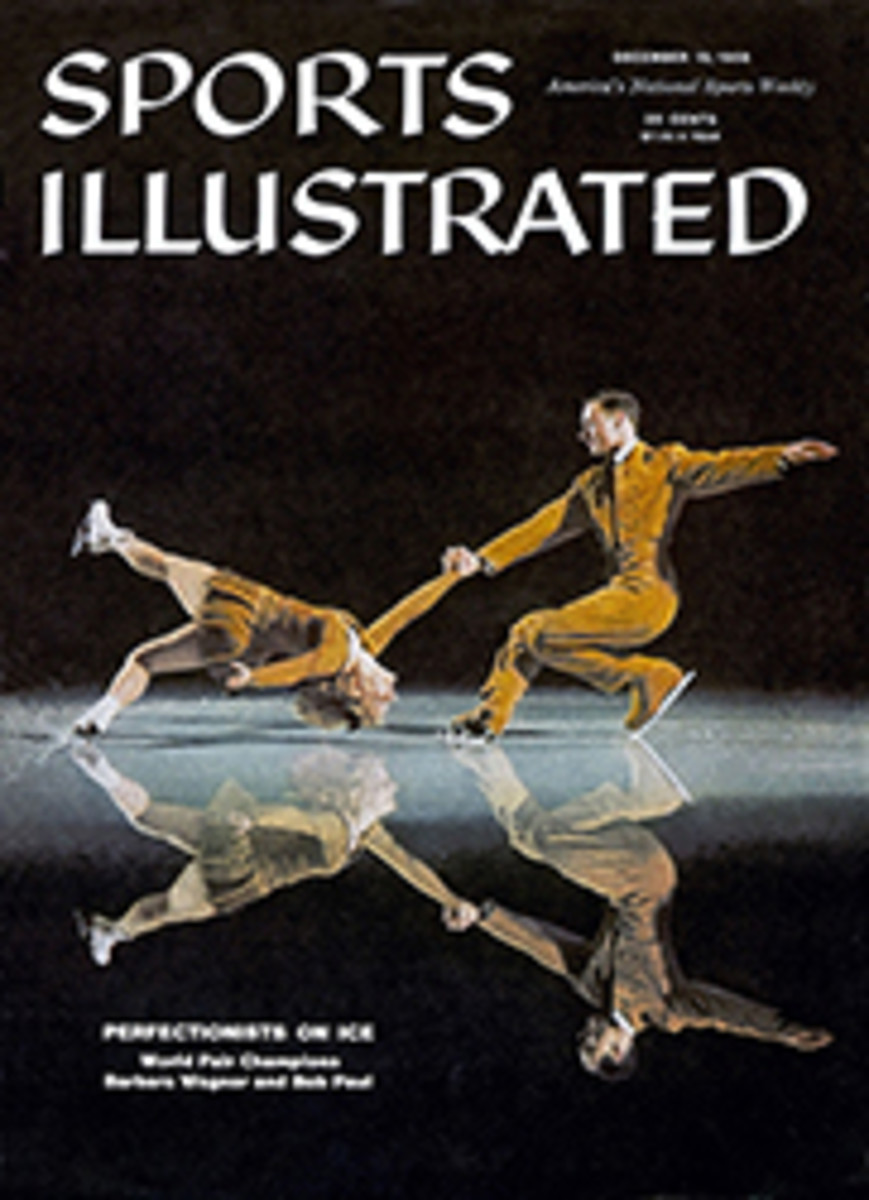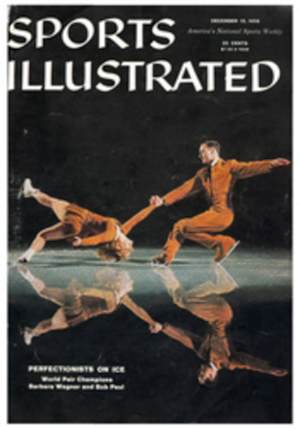
SHORT CUT TO THE SHORTSWING
A year ago on these pages, Willy Schaeffler, coach of Denver University's crack ski team, head of the ski school at Arapahoe Basin, Colo. and Director of Ski Events for the 1960 Olympics, introduced the revolutionary shortswing to America's recreational skiers. Now Willy is back with another skiing revolution, this one a new method of teaching, aimed at beginners. Starting with the scrambling game of tag shown at left, Willy takes a class of youngsters, age 8 to 11, through a series of games and exercises that painlessly inject the fundamentals every skier should have before he undertakes the simplest traverse or turn. Heretofore, a novice's first day in ski school has usually been a clumsy and/or a discouraging experience. Drawn up in a line with a dozen other self-conscious beginners, he is pushed off in a stiff snow-plow before he has mastered the simple art of getting up from the inevitable fall. In the lessons below, however, Willy shows how every novice, by using both the terrain and his own instincts, can cut down the awkward stage and move quickly to his first run on the big mountain.
School starts with game of tag that helps pupils to forget natural self-consciousness of beginners as they flounder after each other. Here, Schaeffler's son Bill reaches out to tag Pat Jump of Georgetown, Colo., while (from left) Lester Johnson dodges toward the camera, Marilyn Ganong slips around behind Pat and Tim Reichwein (right, rear) scurries toward far boundary.
Tag game shown above begins with class divided, instructor in tag zone in the middle. At a signal, pupils try to run across tag zone without being caught.
Square dance, with skiers standing in a circle while one pupil after another weaves in and out among his classmates, is exercise in direction change.
Relay race, with class split into two groups of four (see dots next to starting lines), teaches skiers to make sharp changes in direction as they zigzag toward halfway mark, then becomes balance exercise when racers hop from one track to another on the way back to the finish line.
Basic walking step is shown by Schaeffler, who uses long forward stride plus powerful push with poles and upward swing of arms to get glide and rhythm into movements. Struggling manfully to keep up, Lester Johnson, 10, copies Willy's long stride, but misses with pole action, pushing with both poles at same time instead of using left pole with right foot and vice versa, like Willy.
Warmpup exercises literally keep pupils warm near end of two-hour lesson. On cold days, and particularly at high-altitude resorts like Arapahoe Basin, Colo., where these pictures were taken, beginners tire quickly, suffer from cold fingers and toes. Arm-swinging, toe-touching and jumping-jack exercises help to restore circulation, make last part of the lesson fun rather than frosty torture.
Short tour winds up first lesson. All exercises shown thus far are done on level ground. First downhill runs come on next page: but on tour, instructor should take class on uneven terrain so pupils will get feeling of gliding on gentlest slopes without having to worry about correct downhill position. On tour, they also get off manicured practice slope, learn to handle unpacked snow.
FIRST TIME UP THE HILL
Sidestep is easiest way to get up hill. Above, Willy shows Pat Jump, Tim Reichwein and Danny Johnson how to climb, stepping up and to the side with the uphill ski, then bringing down hill ski alongside before starting the next step (see diagram). For first climb, Willy picks a gentle slope with level platform or resting place at top where class can easily start first downhill run.
Starting down for the first time, Willy tells Danny to touch his boots, thus keeping weight over the skis and counteracting beginner's tendency to fall over backward when skis first start to move.
Low bridge by Danny Johnson and tight squeeze (right) by Marilyn Ganong are good games to get pupils to use down and up movements of knees and ankles they will need later on in bumpy terrain and difficult snow. Other games, such as throwing down a mitten and picking it up, lifting one ski or tossing up ski poles while making slow downhill run improve beginner's balance, help get his mind off skis so that he moves more naturally over the snow.
KICK-TURN AND DOWNHILL POSITION
Half sidestep with kick-turn is best way to climb long hill. Below, Schaeffler shows correct sequence for turn.
Starting kick-turn (1), Willy plants poles uphill, three to four feet apart and two feet from skis. Then he kicks (2) downhill leg up, swings tip up and back (3), leaning on poles for support. With the skis parallel but now heading in opposite directions (4) he shifts weight to lower ski, swings other one around (5), heads in new direction (6).
Trying kick-turn on level ground, Lester heads for trouble as butt of ski hits snow too soon. Kick-turn is much easier to do on slope than on level, should always be started with downhill ski.
Standing on slope, Willy shows pupils how to plant poles in front to keep skis from slipping. By placing poles so, class automatically gets into correct downhill stance, with upper body relaxed, knees flexed, body leaning forward slightly. In this position weight will stay over skis without need of bending to touch boots as shown in first downhill exercise on the opposite page.
LAST STEP TO THE COMMA
Herringbone is most difficult of uphill steps for novices to learn, but is good way to move quickly up gradual incline. Starting out, Willy spreads tips of skis, puts weight on inside edges, leans well forward and uses powerful pole push to keep skis from slipping backward and crossing. With practice, skier can almost run up if slope is not too steep or snow too deep.
Stepping into slope (left) is the beginner's way of checking speed on first attempt at making a traverse. Using the simple change-of-direction step learned in relay race on first page, Willy shows Smokey Anderson, 11, how to angle across the hill in a fairly steep traverse, then step-step-step back toward the slope, lifting uphill ski first each time (see diagram) until he comes to a stop with the skis perpendicular to the fall line, i.e., line of steepest descent.
Tumbling down practice slope in purposeful fall, Willy shows the class how to roll after header so that skis will be resting downhill from body, in the best position for getting up again (see top of next page).
Getting up from fall shown at bottom of opposite page, Willy puts both poles together, bends knees to get boots beneath his body. Next he spreads hands to grip poles at top and bottom, then sticks points into snow on uphill side next to hip. Prom this position, by leaning forward and thrusting with poles, he can rise to his feet with little effort.
Skating on skis duplicates thrust and glide of similar action on ice, helps beginners learn balance and coordination. Novices should start skating near end Of gentle downhill run while skis are still moving forward. Begin by shifting weight to left ski. Then push off from inside edge of left ski and shift weight to right ski. Stay on right ski as long as possible, then push back to left. At first, grip poles in middle and use exaggerated arm swing as shown by Schaeffler and Lester Johnson to help with lift and rhythm.
Ready for mountain, Willy leads class in comma position, basic point of depar ure for all advanced maneuvers. In teaching children, use maximum demonstration, minimum conversation, since small fry can imitate better than they can understand.
SIXTEEN PHOTOS
MARGARET DURRANCE
PHOTO
MARGARET DURRANCE
1
PHOTO
MARGARET DURRANCE
2
PHOTO
MARGARET DURRANCE
3
PHOTO
MARGARET DURRANCE
4
PHOTO
MARGARET DURRANCE
5
PHOTO
MARGARET DURRANCE
6
DIAGRAM
TAG
ZONE
DIAGRAM
START
DIAGRAM
START
FINISH
SRART
FINISH
DIAGRAM
1
2
1
2
START
DIAGRAM
1
2
START
DIAGRAM
1
2
START
DIAGRAM
1
2
START
DIAGRAM
START
1
2

